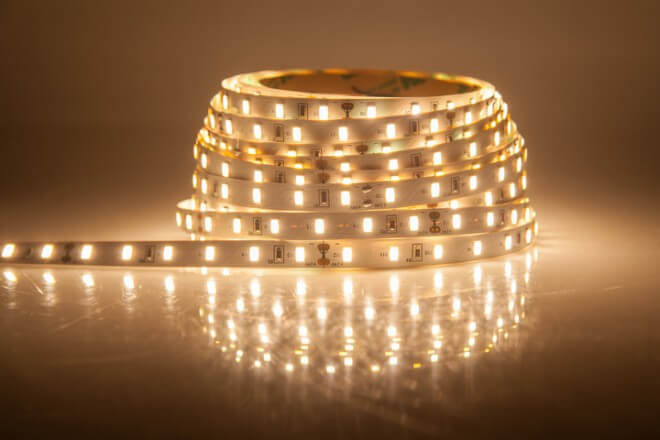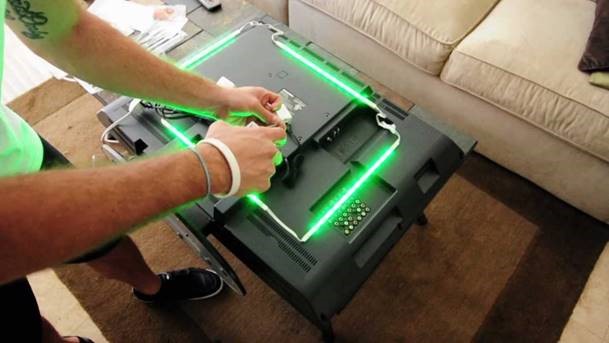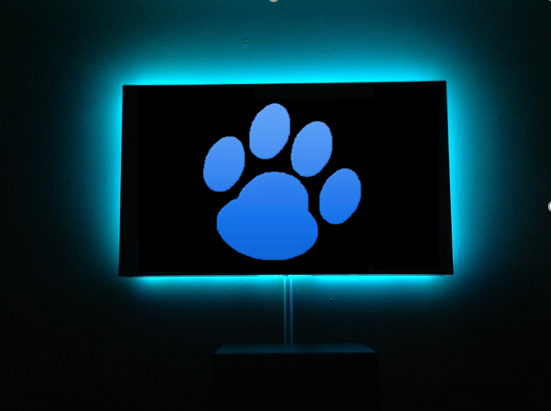
Using LED Light Strips Behind Your Television
By Hagan Schmidt, COO & Lighting Expert – 05/05/17
We all do a few things around the house to make sure that our things stay in good shape.
You do things to maintain your furniture and electronics, but what are you doing to help out your TV?
Installing LED light strips may benefit your vision.
Confused about how a few light strips can benefit your TV and eyes? Read on to learn more.
The screen light problem
Before talk about LED light strips and your TV, we need to give you a little bit of context.
Whenever you look at something your pupil needs to dilate to regulate the amount of light entering the eye.
Many people believe that pupil dilation is determined on light alone, but that’s a common misconception.
We live in a world that’s dominated by screens. The TVs, smartphones, and computers we look at could have unintended effects on our vision.
When we look at a bright TV screen, our eyes are essentially focusing on an extremely bright light that’s floating in a very dim surrounding area.
Our brains perceive that the screen is bright in relation to our surrounding environment, but our eyes still attempt to adjust based on the overall brightness of the entire area.
Because of this, it’s easy for eyes to become fatigued when watching TV.
Eye strain can be a real issue for people. In extreme cases, people may even get slight headaches or migraines.
Some people may try to combat this issue by leaving on lights in their TV room, but this can create its own unique set of problems.
Most rooms have ceiling, floor, and table lamps. Many are located either above or in front of the TV screen, some are located at around the same height of the viewer’s head.
When you turn on lights to keep the room bright you do solve the issue of having a bright screen in a dim room, but you don’t solve the eye strain problem.
Lighting that’s to the side or behind the viewer will project light on the viewing surface. This can cause image glare and decrease contrast.
LED light strips and bias lighting
Bias lighting is the term for any kind of ambient light that can be placed behind a screen. It can solve the problems associated with light and eye strain and even makes watching TV more pleasurable.
One of the things bias lighting can improve upon are colors and contrast.
The grays and blacks on your TV screens will look richer and the contrast will seem more powerful.
If you feel like you’re spending time adjusting your TV’s brightness and contrast settings, the problem may not be the TV. It could be your room lighting.
Adjusting the TV repetitively may harm the picture quality or wear out the backlight. LED light strips help your picture problems.
Solving the light problem
Some people will spend hundreds of dollars to solve their lighting problems. If you want you could get an expensive lighting system that’s designed to provide bias lighting.
Or you could spend a couple of dollars on a simple DIY project with LED light strips.
You don’t need to be an electrician or an AV expert to install bias lighting behind your TV. If you follow these tips you’ll solve your light problem in a matter of minutes.

Get the right equipment
You don’t need much for this DIY project, but there are a few essentials:
- Flexible LED light strips
- Painters or masking tape
- Tape measurer
Measure accurately
You don’t want to put your lights in the wrong place when you’re ready to install.
Use tape to outline your TV before you remove it to install the lights. You don’t want lighting elements to be exposed, and the lights need to fit inside of the square frame.
Consider placement
If you do a search for DIY TV backlighting, you’re going to find scores of videos.
Some people place LED light strips on the wall behind their TVs, others will do it directly on the TV.
This placement depends on your preference. Since our lights are easy to place, you could do it any way you choose!

Think about decor
The right LED light strips gives you freedom.
Some choose to hide their bias lighting, but others may choose to make it a part of their decor scheme.
A soft white hue may be the perfect lighting choice.
Want to get creative? Pick your favorite color led lights.
Your turn
Have any questions about how bias lighting could improve your TV viewing experience?


